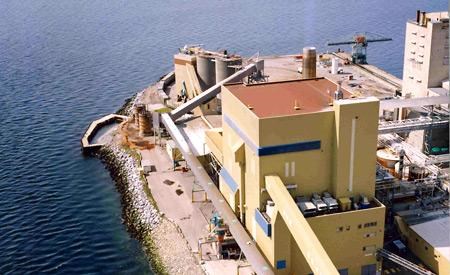Electricity production at Catalyst Paper Corporation’s Powell River division increased greenhouse gas (GHG) emissions at the operation, according to the company’s 2012 sustainability report.
The report states that in 2012, the Powell River mill took product diversification to a new level by selling energy as well as paper. “This followed a capital upgrade that allowed it to generate 119,400 MWh [megawatt hours] of additional electricity for sale to BC Hydro, thus leveraging existing infrastructure and expertise.”
The operational change resulted in a large increase of GHGs at the mill, the report notes.
Sarah Barkowski, environment manager at the Powell River division, said the mill increased the powering rate of its power boiler by about 33 per cent. “We made more steam and we used that extra steam to make power,” she said.
Because of that, the GHG emission rate has increased, she explained. “But overall, there has been a net reduction in greenhouse gas emissions,” she said. “This is because our greenhouse gas emission rate is lower than that of the power plant at which we displace power.”
Overall, more renewable energy was made, Barkowski said, and less fossil fuel is being used today to generate electricity.
The mill’s power boiler is mostly powered by biomass, or hog fuel, Barkowski explained, but natural gas is used as an auxiliary fuel to maintain steam production. “When the moisture level of the hog fuel is high, we found we had to burn more of the auxiliary fuel, the natural gas, in order to maintain the same steam production,” she said. “What we’re doing now, we have reduced the boiler operating rate during those periods when we’re consuming high-moisture hog fuel and that appears to be working to reduce our consumption rate of natural gas, which of course in turn reduces our greenhouse gas emission rate.”
The sustainability report states trials in early 2013 suggest that use of dryer wood waste fuel should limit natural gas use even at higher capacity boiler operation. A planned rotor replacement will also allow for more efficient electricity generation from available steam. “Powell River will continue to generate electricity for sale in 2013,” the report states.
BC Hydro has a number of power plants that it owns and operates which run on fossil fuels, Barkowski pointed out. “They also purchase power from plants, transfer it and sell it to other places,” she said. “Those can be coal-fired plants. All of those plants, whether they’re running on natural gas or coal, they’re all going to generate more greenhouse gas emissions per megawatt hour than our plant will.”
The arrangement Catalyst has with BC Hydro supports the province’s energy plan, Barkowski also said. “It reduces the province’s reliance on fossil fuels,” she said.
The report notes that various other metrics were impacted by the additional electricity generation at Powell River, including particulate and sulphur dioxide emissions, solid wastes and fuel and total energy use. “The mill’s water intensity, which is based on treated effluent discharges, was not impacted,” the report states. “But total water use inclusive of non-effluent discharges was up significantly, as the energy generation required increased volumes of cooling water.”
The average daily flow of the non-contact cooling water was 68,309 cubic metres in 2012, Barkowski said. “The ministry has put limits on that flow and it has to be below a certain temperature,” she said. “That water is monitored continuously and it has to meet certain parameters for pH, temperature and flow and so on.”
The 2012 sustainability report notes that Catalyst’s total direct GHG emissions were down, mainly due to the permanent closure of a carbon-intensive recycled paper mill in Arizona. GHGs were one-fifth of 1990 levels at Canadian operations, but were up from a year earlier reflecting the impact of increased electricity generation at Powell River.



